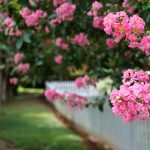In San Antonio, it’s the dry, hot summer months that present the biggest obstacles to your landscape. But choosing native plants with a diverse mix of adaptations for survival can make all the difference.
In Texas, and San Antonio in particular, it’s the summer months that present the biggest obstacles to your landscape. High heat and low precipitation dominate, creating conditions that generally increase a plant’s water needs and use. In other words: drought.
The first and easiest way to avoid drought is to not experience it at all. How do you do that? By choosing native, drought-tolerant plants for your landscape.
Many Texas native wildflowers fall into this category. As annuals, they grow during the winter, flower during the spring and spend the heat of the summer as seeds waiting for fall rains to sprout and begin the cycle anew.
A few perennials use this strategy as well. Take prairie larkspur. Its robust but relatively shallow root system takes advantage of abundant spring-time soil moisture, but the above-ground plant completely disappears during the summer. Plants that produce bulbs, like rain lilies, also fall into this category. They have shallow root systems that quickly snatch up water when it’s abundant. With this easily obtained water, they produce sugars in large amounts and store it in their bulbs so they don’t have to photosynthesize during hot weather.

On the other end of the spectrum, some plants embrace the heat of summer by tapping into water available deep in the soil, outside the blistering reach of the sun. In central Texas, plants have developed diverse root systems to take advantage of water stored in different layers of soil. The first is called a fibrous root system, this is the kind that grasses and many herbaceous wildflowers like mealy blue sage possess. They completely fill the top few feet of soil with fine, branching roots that can take advantage of the water stored in a large volume of soil.

Another type of root system is the taproot and gayfeather is a great example of this. Their roots bypass the first few feet of soil, avoiding the area already taken by the fibrous grass roots, and dive deep extending several yards, even finding cracks in limestone bedrock to reach moisture locked away from almost all other plants.

Some evergreen shrubs take things a step further. Not only do they produce vast root systems, they have built-in sunscreen. Mountain laurel, agarita and evergreen sumac all grow a thick, waxy cuticle that prevents water loss from excess transpiration. Think of it as an extra layer of skin that protects the leaves from the sun’s rays. When other plants wilt in the summer heat these plants remain green and turgid.

Of course, some plants don’t have to rely solely on summer soil moisture to survive. Succulents have the ability to take up water when the soil is wet and store it in their tissue for times when water is scarce. This gives them the upper hand in the competition for water because other plants are limited to taking in water as they use it.
But this adaptation comes at a cost, as succulents have lost the ability to limit the water they absorb — which is why the easiest way to kill a cactus is to over water it. So if you’re thinking of installing any kind of cactus, agave or yucca, skip the drip irrigation and your landscape will actually look better and have greater longevity.
Most people recognize that placing plants with similar water needs together helps with water conservation. Why not take that a step further and create a landscape containing drought-tolerant plants with a diverse mix of adaptations for survival. This way each plant can live to its full potential without too much competition from its neighbors.
When a garden is laid out this way, you’ll notice more season variation as each adaptation has a different season to shine.




